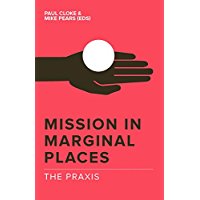Hope where Christ is found
 David Primrose, Director of Transforming Communities in the Diocese of Lichfield and a trustee of Church Action on Poverty, reviews the first two volumes of an exciting new series edited by Paul Cloke and Mike Pears: Mission in Marginal Places.
David Primrose, Director of Transforming Communities in the Diocese of Lichfield and a trustee of Church Action on Poverty, reviews the first two volumes of an exciting new series edited by Paul Cloke and Mike Pears: Mission in Marginal Places.
If you are excited by the title, then you won’t be disappointed by the content. Ann Morisy observed that it was to the discipline of geography that we must look for fresh missiological insights. Paul Cloke is Professor of Human Geography at Exeter, and Mike Pears’ doctorate is in theological and ethnographic studies of place. In this six-volume series, they explore mission in marginal places with books on the theory, the praxis, the stories, exploring spiritual landscapes, the peaceful way, and placing the powers.
These books develop the theme that effective mission requires attention to the local, particularly in the context of globalisation. Indeed it is in places of marginalisation that the gospel is most life-giving. This series locates hope where Christ is and was to be found.
“It is in places of marginalisation that the gospel is most life-giving.”
Cloke and Pears have gathered material from a range of contemporary practitioners. Contributions for volume one are from Stuart Christine, Stephen Finamore, Juliet Kilpin, Sian Murray Williams, David Purves, Cathy Ross, and Andrew Williams. The second volume includes Adam Bonner, Naomi Clifton, Gordon Cotterill, Sam Ewell, Martin Gainsborough, John Hayes, Chris Sunderland, Samuel Thomas, and Andrew Williams.
It’s reassuring to recognise authenticity in the narratives of those whom I know personally, with little exaggeration of the challenges encountered or of the impact achieved. There is a global dimension, with accounts from Brazil, Cambodia, Ethiopia, Italy, New Zealand, Vietnam, and material from the UK around London, Bristol, Birmingham, Exeter, Glasgow, Manchester and Wolverhampton.
“It is on the margins that hope can be discerned and good news discovered”
There is an explicit political perspective, with the rejection of neoliberalism’s promise that globalisation brings prosperity to all. Hence it is on the margins, with those who are excluded, at the boundaries of conflicting social values, that hope can be discerned and good news discovered.
The first volume has three sections, each with individual contributions leading to an editorial conversation. First it explores the incarnation through communities of place, seeing how institutional models of church have to be discarded in the context of complex vulnerability. Then, Christ-like love is exposed in a section challenging divisions predicated on difference. Finally, theological reflections on the cross, peace, and hope, draw together contemporary and scriptural material to argue for socially active mission in marginal places for the transformation of all.
“Institutional models of church have to be discarded in the context of complex vulnerability”
The second volume has five sections, seeking understanding in the political, economic, social, environmental, and creative realms. The critique of contemporary society is persistent, with personal stories of fragile hope offered with humility. Sensitivity to context excludes any suggestion that an example of good practice is to be replicated in another location, yet all provide, to varying degrees, opportunity to the reader for personal reflection and inspiration.
The volumes reference numerous contemporary theologians and others such as Luke Bretherton, Walter Brueggermann, David Bosch, Kathy Galloway, René Girard, Jurgen Habermas, John Milbank, Ann Morisy, Henri Nouwen, Robert Putnam, Jean Vanier, Mirosalv Volf, Jim Wallis, Rowan Williams, and Tom Wright. There is a wealth of imagery, and a plethora of concepts several of which were new to me. I look forward to the publication of the next four volumes in 2017 and 2018.
